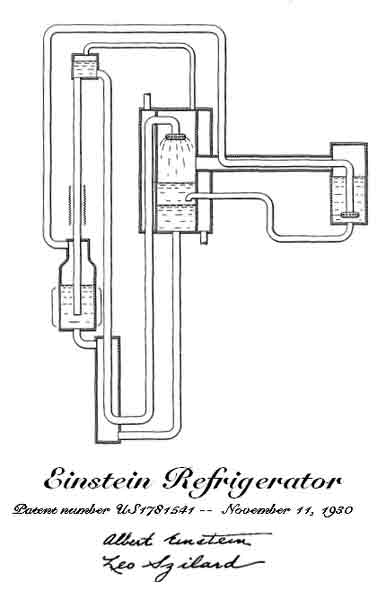Would you believe that in 1930 Albert Einstein invented, and patented, a refrigeration system that uses ammonia, butane, and water instead of environmentally damaging Freon gases? This invention uses no electricity, has no moving parts, and could reduce greenhouse gases if replicated today!
IS THIS TRUE?
It seems many people are not even aware that Einstein, along with his colleague, Hungarian physicist Leo Szilard, developed this practical refrigerator in 1930. The invention was in direct response to a 1926 incident involving a family in Berlin that had been killed by poisonous gases leaking from a refrigerator. Einstein and Szilard were then inspired to invent a safer alternative to current refrigeration systems. Their ultimate goal was to invent a refrigerator that required no electricity and no moving parts. They believed this would alleviate the chance of seals leaking and gas escaping, thereby providing a safer in home refrigeration unit.
In 1930, they were successful in designing, and building, a refrigerator that had no moving parts and used only pressurized gases to create low temperatures. The premise of this design was used in the first domestic refrigerators; however the concept was abandoned when more efficient and affordable Freon compressors became popular in the 1950s.
Current refrigeration systems are notoriously damaging to the environment. They work by compressing and expanding man-made greenhouse gases called Freon. Freon is a huge contributor to The Greenhouse Effect and the depletion of the ozone layer. This process is far more damaging than carbon dioxide (also a useful, and less damaging alternative, for refrigeration). Einstein and Szilard’s refrigerator completely eliminates the need for Freon. Their design uses ammonia, butane, and water to take advantage of the fact that liquids boil at lower temperatures when the air pressure around them is lower. Inside the unit there is a container of butane, if you introduce a gas above the butane, the liquid will boil at a lower temperature, as it boils, it uses energy from its surroundings. As the butane burns, the ammonia evaporates and is absorbed by the water. The condenser pressure liquefies the butane, and as it passes back into the evaporator to start the process again, the ammonia provides the cooling for the unit. This interaction is what creates and maintains the lower temperatures.
Pressurized gas refrigerators based around Einstein’s design were replaced by the Freon compressor refrigerators that we use today, primarily because Einstein and Szilard’s design was not very efficient on a large scale. Many scientists and environmentalists believe that with a few tweaks Einstein and Szilard’s refrigerator could become markedly more efficient, and may make a comeback to help protect the environment. Since the only energy needed is the heat pump, some scientists are even looking into powering the pump with solar energy.
Einstein and Szilard’s 81 year old invention may very well be just what the planet is in need of in terms of refrigeration. No greenhouse gasses. No moving parts. No electricity required. Sometimes the simplest answer is the best answer.
← BACK TO ALL POSTS

